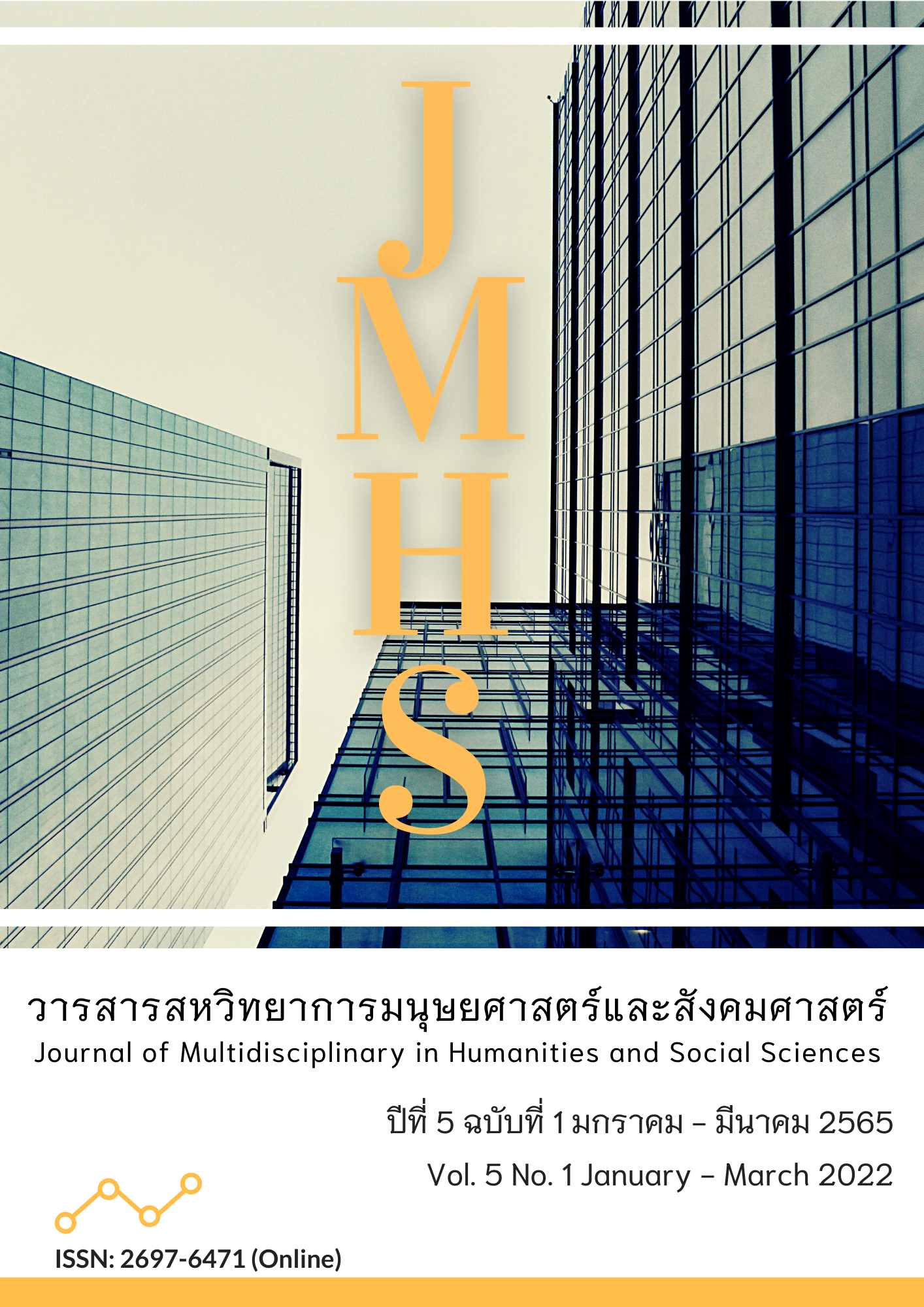A Study of Vipassana Meditation Practice in Uppalawanna Sutta
Main Article Content
Abstract
The objectives of this paper were 1) to study important dharma principles in the Uppalavana Sutta and 2) to study the practice of Vipassana meditation in the Upapawanna Sutta. It is a sutra on Phra Ubonwanna Bhikkhuni. He was extremely beautiful, skin-like as a lotus flower. While he was going out for the alms round, the devil tried to cause fear. The Elder had taught the devil the Dharma so that even though he was alone, he would not feel frightened. The devil could not see him because he was a master of the mind. Growing in power, freed from all attachments, is that you have attained enlightenment, and when the devil hears this, he is saddened that the Elder had realized it and lost his sight. The main dharma principle in Uppalwanna Sutta is the Iddhipada: path of accomplishment; basis for success, namely Chanda: will; zeal; aspiration, Viriya: energy; effort; exertion; perseverance, Citta: thoughtfulness; active thought; dedication, and Vimamsa: investigation; examination; reasoning; testing, which are important virtues that support the development of Vipassana meditation. Phra Ubonwanna Bhikkhuni was regarded by the Lord Buddha as the very powerful Bhikkhuni.
Article Details

This work is licensed under a Creative Commons Attribution-NonCommercial-NoDerivatives 4.0 International License.
Views and opinions appearing in the Journal it is the responsibility of the author of the article, and does not constitute the view and responsibility of the editorial team.
References
ชัยชาญ ศรีหานู. (2564). วิเคราะห์คำสอนวิปัสสนาในเตภูมิกถาที่มีผลต่อคตินิยมเชิงพุทธในสังคมไทย. วารสาร มจร บาฬีศึกษาพุทธโฆสปริทรรศน์, 7(1), 12-26.
พระธรรมกิตติวงศ์ (ทองดี สุรเตโช). (2551). พจนานุกรมเพื่อการศึกษาพุทธศาสน์ คำวัด. กรุงเทพฯ: สถาบันบันลือธรรม.
พระธรรมธีรราชมหามุนี (โชดก ญาณสิทฺธิ). (2550). คู่มือสอบอารมณ์กรรมฐาน. (พิมพ์ครั้งที่ 5). กรุงเทพฯ: โรงพิมพ์มหาจุฬาลงกรณราชวิทยาลัย.
พระพรหมคุณาภรณ์ (ป.อ. ปยุตฺโต). (2557). พุทธธรรม ฉบับปรับขยาย. (พิมพ์ครั้งที่ 40). กรุงเทพฯ: ผลิธัมม์.
พระพรหมมังคลาจารย์ (ปัญญานันทภิกขุ). (2539). เคล็ดลับของความดับทุกข์. กรุงเทพฯ: เลี่ยงเชียง.
พระพรหมโมลี (สมศักดิ์ อุปสมมหาเถร). (2550). วิปัสสนานัย เล่ม 2. (พระคันธสาราภิวงศ์, แปล). นครปฐม: ซีเอไอ เซ็นเตอร์.
พระพุทธโฆสเถระ. (2548). คัมภีร์วิสุทธิมรรค. (สมเด็จพระพุฒาจารย์ (อาจ อาสภมหาเถร), แปล). (พิมพ์ครั้งที่ 6). กรุงเทพฯ: ประยูรรวงศ์พริ้นท์ติ้ง.
พระมหานพดล นวตลปญฺโญ, พระครูสุธีคัมภีรญาณ (ประมวล) และ พระมหามิตร ฐิตปญฺโญ. (2564). รูปแบบการปฏิบัติธุดงควัตรของพระสงฆ์ในลุ่มแม่น้ำโขง (ไทย-ลาว). วารสารศิลปการจัดการ, 5(2), 325-339.
พระสมชาย บัวแก้ว, พระมหาบุญศรี วงค์แก้ว และ สุเชาวน์ พลอยชุม. (2564). อภิสมาจาร: กระบวนการพัฒนาบุคลิกภาพตามแนวพระพุทธศาสนา. วารสารศิลปการจัดการ, 5(3), 895-907.
พระโสภณมหาเถระ (มหาสีสยาดอ). (2549). มหาสติปัฏฐานสูตร ทางสู่พระนิพพาน. (พระคันธสารา ภิวงศ์, แปล). กรุงเทพฯ: ไทยรายวันการพิมพ์.
พระอุดรคณาธิการ (ชวินทร์ สระคำ) และ จำลอง สารพัดนึก. (2552). พจนานุกรมบาลี-ไทย สำหรับนักศึกษา ฉบับปรับปรุงใหม่. (พิมพ์ครั้งที่ 6). กรุงเทพฯ: ธรรมสาร.
มหาจุฬาลงกรณราชวิทยาลัย. (2539). พระไตรปิฎกภาษาไทย ฉบับมหาจุฬาลงกรณราชวิทยาลัย. กรุงเทพฯ: โรงพิมพ์มหาจุฬาลงกรณราชวิทยาลัย.
มหาจุฬาลงกรณราชวิทยาลัย. (2552). อรรถกถาภาษาไทย ฉบับมหาจุฬาลงกรณราชวิทยาลัย. กรุงเทพฯ: โรงพิมพ์มหาจุฬาลงกรณราชวิทยาลัย.
สมเด็จพระพุทธโฆสาจารย์ (ป.อ.ปยุตโต). (2561). พจนานุกรมพุทธศาสตร์ ฉบับประมวลธรรม. (พิมพ์ครั้งที่ 41). กรุงเทพฯ: ผลิธัมม์.
สมเด็จพระพุทธชินวงศ์ (สมศักดิ์ อุปสมมหาเถระ). (2554). อริยวังสปฏิปทา. กรุงเทพฯ: ประยูรสาส์นไทย การพิมพ์.
เสฐียรพงษ์ วรรณปก. (2555). พุทธสาวก พุทธสาวิกา: ประมวลประวัติพระเถระพระเถรีสมัยพุทธกาล. (พิมพ์ครั้งที่ 2). กรุงเทพฯ : ธรรมสภา.
อรชร ไกรจักร์, เเม่ชีกฤษณา รักษาโฉม และ พระมหาวรัญธรณ์ ญาณกิตฺติ. (2564). บุคลิกภาพของพระภิกษุตามหลักเวสารัชชกรณธรรม. วารสาร มจร บาฬีศึกษาพุทธโฆสปริทรรศน์, 7(3), 113-125.
Damnoen, P.S. (2021). The Development of Student Characteristics in According to the Nawaluk Framework of the Buddhist integration of Buddhapanya Sri Thawarawadee Buddhist College. Asia Pacific Journal of Religions and Cultures, 5(2), 126-135.
Tan, C. C., & Damnoen, P. S. (2020). Buddhist Noble Eightfold Path Approach in the Study of Consumer and Organizational Behaviors. Journal of MCU Peace Studies, 8(1), 1–20.


